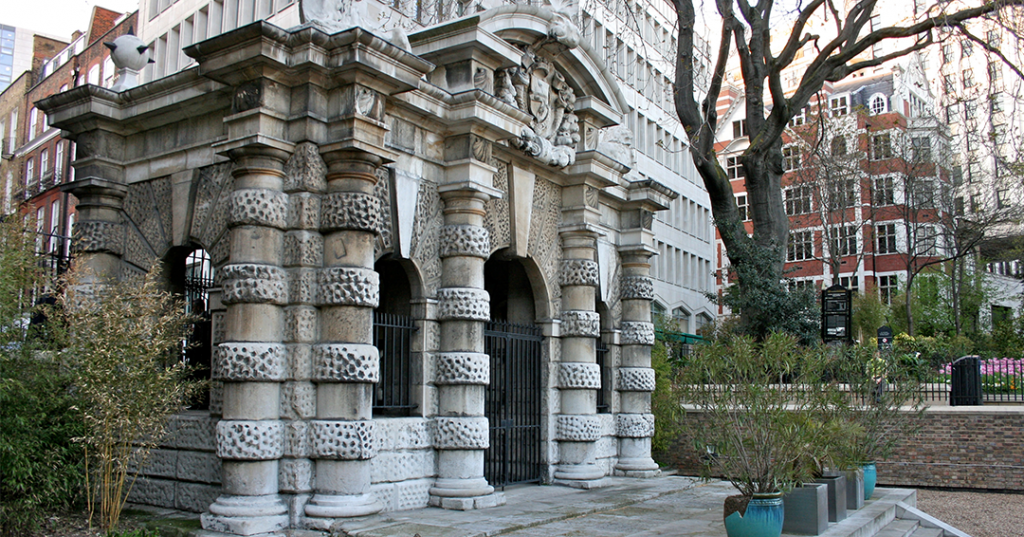The York Watergate
Posted in 17th Century, Architecture, Editorial blog posts, gardens, Green, Pre-1700 and tagged with Architecture, Charles I, design, Embankment, Inigo Jones, Layers of London, Villiers

When the Duke of Buckingham ordered his York House (approximately located at present day 38 Strand) to be modernised in 1623, “it was customary for nobility to be conveyed by water” [1] while the less convenient carriages were preferred for state purposes. This made the building of private watergates by the river very common in noblemen’s houses, “and stairs led from the grounds to the water-side, for the convenience of taking boats.”

The York Watergate in Gater and Wheeler, 1937, Plate 32.
Long thought to have been built by Inigo Jones (1586-1647), it is today believed that this gate is the work of the appropriately named master-mason Nicholas Stone (1586-1647). It is one of the few remaining examples in London of this bold, strong Italianate style typical of the reign of Charles I. [2]
The door is today mostly seen from the river side of the park, which must have been (purposely) impressive to visitors with its large Portland stone archway upon steps and lateral apertures, the huge keystones, and its four heavily rusticated (textured) doric columns.
The ornamentation makes use of Villiers (the Duke of Buckinham’s family name) heraldry: escallops in the frieze, lions, shields and anchors — all reference to the Duke’s admiralship. The Villiers arms are proudly shown in the curved pediment in the centre, using the Renaissance language of architecture: in a carved cartouche (ie. a tablet in a scroll-like frame) surmounted by another large escallop, the family’s cross and five escallops are encircled by the riband of the order of the Garter and the ducal coronet.
The Northern side, that is, away from the river and facing towards where the house stood, is the soft — almost charming — complement to the South facade: the three arches are now of equal height, separated not by columns but by unornamented pilasters, with the elevation not being as dramatic as its southern counterpart. The keystones are now marked with ornamental shields: in the centre one finds the arms of the Villiers family, and on the sides the traditional anchors. Finally, Buckingham’s motto is carved on the frieze: in latin, “The Cross is the Touchstone of Faith”.

Serlio’s dramatic gate, from Book XXX of his 1551 Libro Estraordinario.
Just like his colleague Inigo Jones, Nicholas Stone was widely influenced by Sebastiano Serlio and Andrea Palladio, especially by the former’s more daring and vivid style (that we would today associate with Mannerism), which frequently resorted to dramatic rustication and depth variations.
The picturesque effect of this grand door was greatly reduced by the creation of the Thames Embankment which pushed the Thames’ waters 137m down. As W. Hutchings wrote in his 1909 London Town, “the presence of this beautiful structure helps one realise the difference which has been made by the creation of the Embankment, for whereas now it is some hundreds of feet away from the river, the steps at its base used to be lapped by the tide.”[3]
There is a unique picturesque quality to the watergate today: it stands here, isolated, deprived of its original function, poetically reminding the wanderer of the past of when its stones were still freshly carved, when York House was still standing, and when the Thames splashed its base.
*
Sources
[1] John Britton and Augustus Pugin, Buildings of London, London : J. Taylor, Volume II, 1826, p. 39
[2] G H Gater and E P Wheeler (ed), Survey of London: Volume 18, St Martin-in-The-Fields II: the Strand, London, 1937, Plate 32
[3] W. W. Hutchings, London Town past and present, New-York: Cassell, 1909
[4] James Stevens-Curl and Susan Wilson, The Oxford Dictionary of Architecture, Oxford University Press, 2016 (3rd Edition)
Paul is a volunteer for the Strandlines and Layers of London collaboration. Explore all of the Strandlines and Layers of London collaborative posts, which bring together over 500 years of maps and images, on the Layers of London site.


[…] banks of the Thames. The seventeenth-century watergate is still present (on that topic also the York Watergate), and acts as a visual reminder of the colossal work undertaken by Joseph Bazalgette at the time of […]
[…] centuries; using the Thames as a shortcut was a common solution, hence the many (mostly now lost) watergates on the […]
[…] Villiers Street as we know it today was built in the 1670s, when the second Duke of Buckingham and former royal favourite to Charles II, agreed to the dismantling of York House on the Strand, on the understanding that the surrounding streets would be named in his honour. At the time of its demolition, York House had been in his family’s hands for half a century and its destruction was part of a land transaction aimed at solving some fairly serious financial troubles. We know a lot about the Villiers family, but rather less about what went on in the house under its ownership and York House’s role as a centre of art, culture and entertainment helps us to imagine elite life on the Strand 400 years ago. This is particularly intriguing, because all that remains of the place today is the iconic Italian watergate on the embankment (see Paul Guhennic’s strand on the York Watergate). […]